LARYNX
1/64
There's no tags or description
Looks like no tags are added yet.
Name | Mastery | Learn | Test | Matching | Spaced |
|---|
No study sessions yet.
65 Terms
which tract in the body is the larynx a part of
the larynx is part of the respiratory tract
what is the larynx reinforced by
the larynx is reinforced by cartilage
what is special about the cartilages in the larynx
the cartilages in the larynx articulate with each other
how do the cartilages in the larynx articulate with each other
the cartilages in the larynx articulate with each other at synovial joints
what do the synovial joints allow the laryngeal cartilages to do
the synovial joints allow the laryngeal cartilages to be moved with precision relative to each other
what is the primary function of the larynx
protect the lower respiratory tract by…
preventing inhalation of food/ liquids during swallowing/ vomiting
what is the secondary function of the larynx
generation of noise by vibration of vocal folds (at different frequencies) as air moves past them
i.e. phonation
what occurs to the laryngeal cartilages during swallowing
the laryngeal cartilages elevate during swallowing
which structures make up the laryngeal skeleton (6)
hyoid bone
thyroid cartilage
cricoid cartilage
arytenoid cartilage
corniculate cartilage
epiglottis
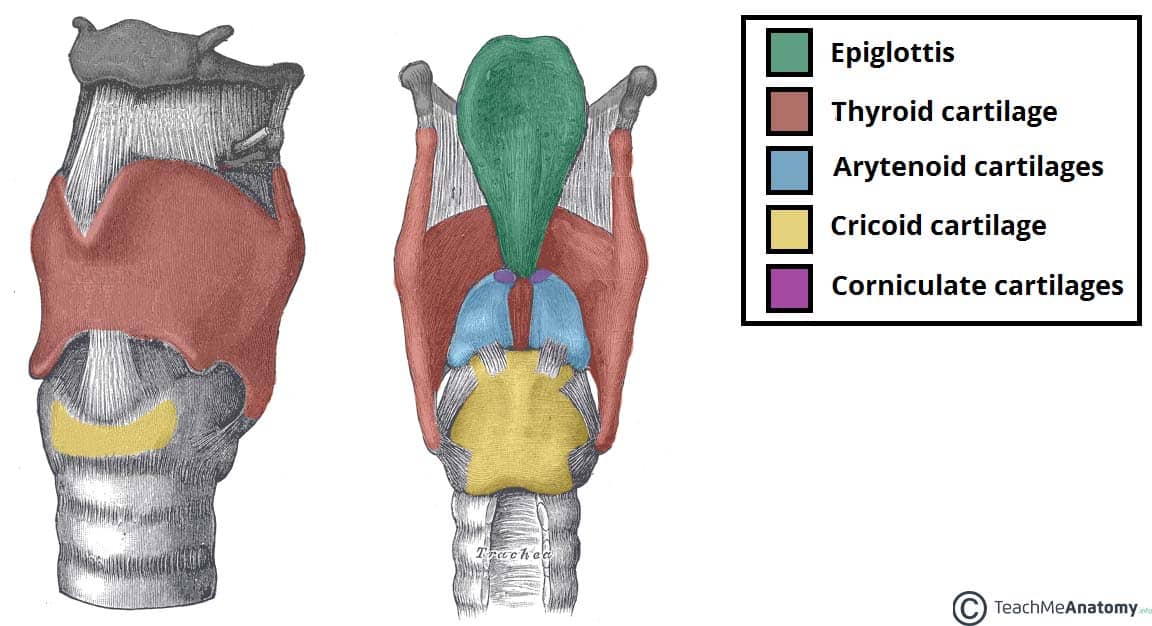
the laryngeal skeleton: hyoid bone
joined to thyroid cartilage by thyrohyoid membrane

the laryngeal skeleton: thyroid cartilage
joined to hyoid bone by thyrohyoid membrane
joined to cricoid cartilage by cricothyroid joint

which two structures is the cricothyroid joint formed by
the inferior horn of the thyroid cartilage and the lateral aspect of the cricoid cartilage
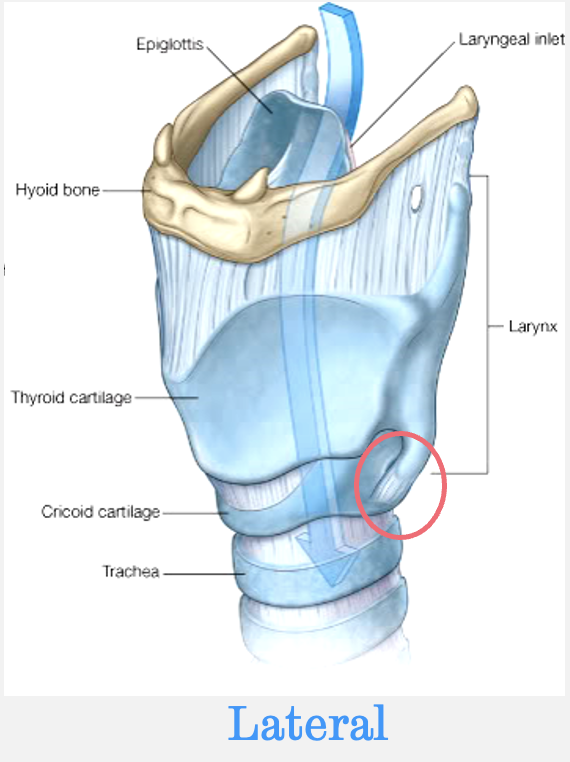
what is the function of the cricothyroid joint
allows the cricoid cartilage to swing up and meet the thyroid cartilage
the laryngeal skeleton: cricoid cartilage
shaped like a signet ring (flat face of ring faces posteriorly in the larynx)
the only COMPLETE RING of cartilage in the respiratory system
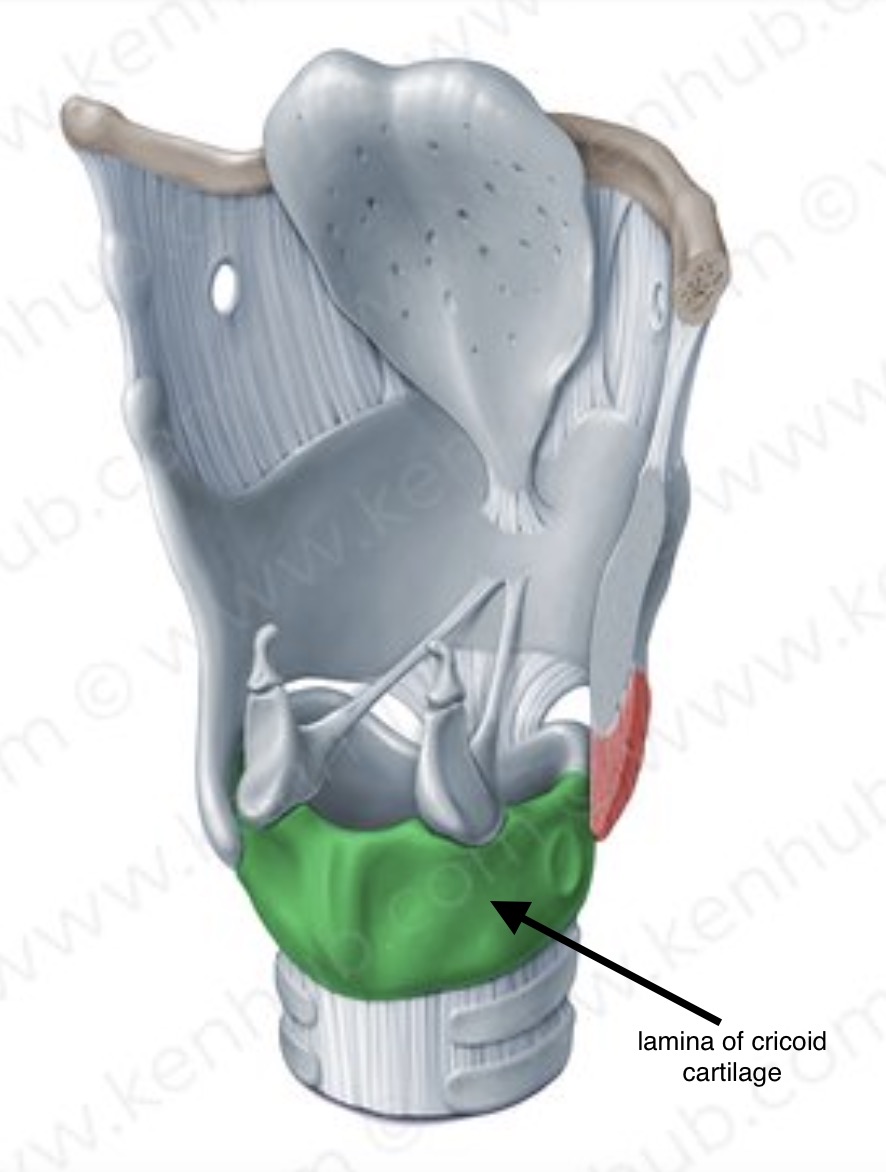
the laryngeal skeleton: arytenoid cartilage
the arytenoid cartilages are paired
the vocal folds attach to the vocal processes of the arytenoids posteriorly and to the thyroid cartilage anteriorly
the arytenoid cartilages form 2 synovial joints with the cricoid lamina » cricoarytenoid joints

what movements are possible at the cricoarytenoid joints (3)
sliding apart (abduction)/ sliding together (adduction)
rotation about a vertical axis e.g. inserting a screw from above and twisting it left and right
tilting backwards/ tilting forwards
movements at the cricoarytenoid joints: sliding
sliding medially i.e. adduction » closes vocal folds
sliding laterally i.e. abduction » opens vocal folds

movements at the cricoarytenoid joints: rotation about a vertical axis
rotation inwards i.e. adduction » closes vocal folds
rotation outwards i.e. abduction » opens vocal folds
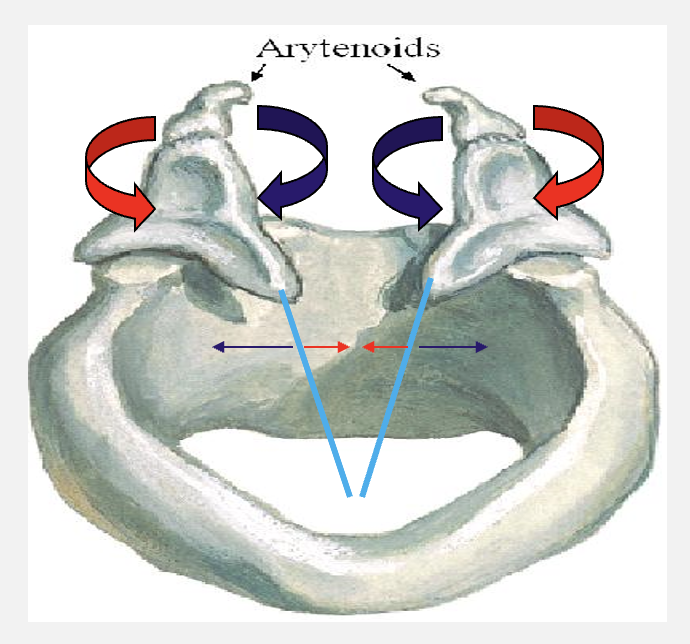
movements at the cricoarytenoid joints: tilting
tilting backwards » increases length and tension - decreases thickness
tilting forwards » decreases length and tension - increases thickness
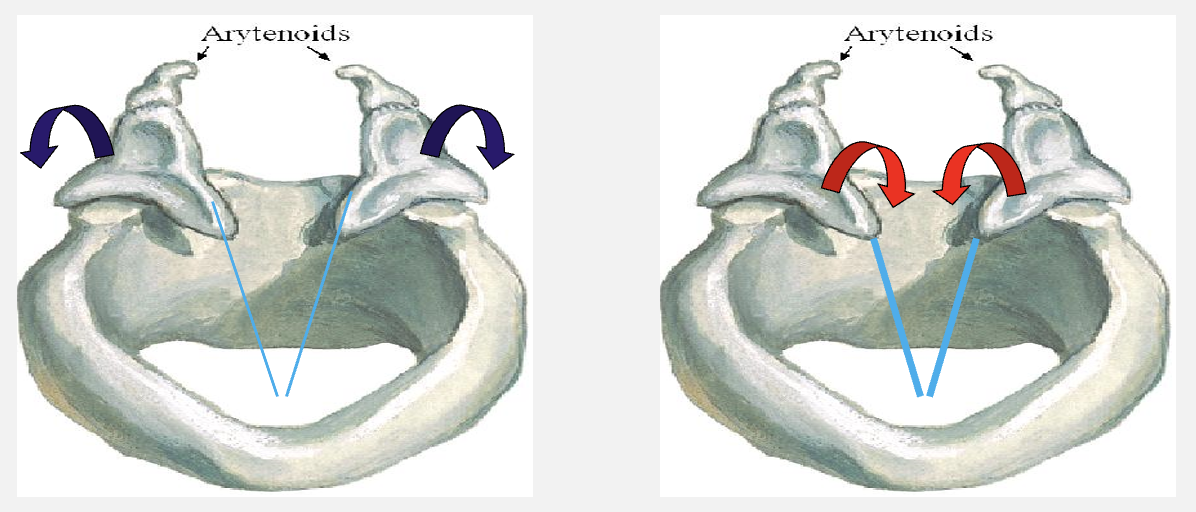
the laryngeal skeleton: epiglottis
flap of cartilage
protects the trachea by folding backwards during swallowing
prevents food and drink from entering lungs
which cartilage is the Adam’s apple
the thyroid cartilage
what are the laryngeal folds
laryngeal folds are the broad term for the soft tissue folds in the larynx i.e. the vocal folds and the vestibular folds
diagram of vocal and vestibular folds

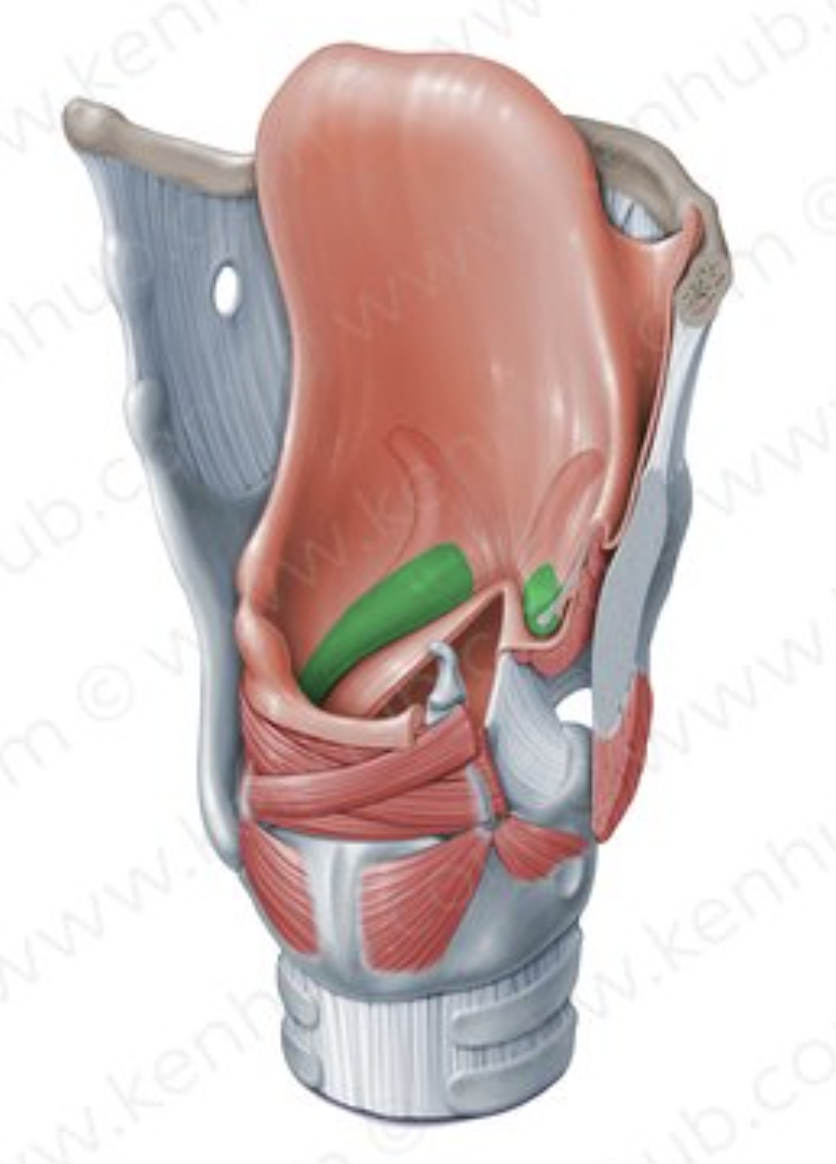
name this structure
vestibular/ ventricular folds
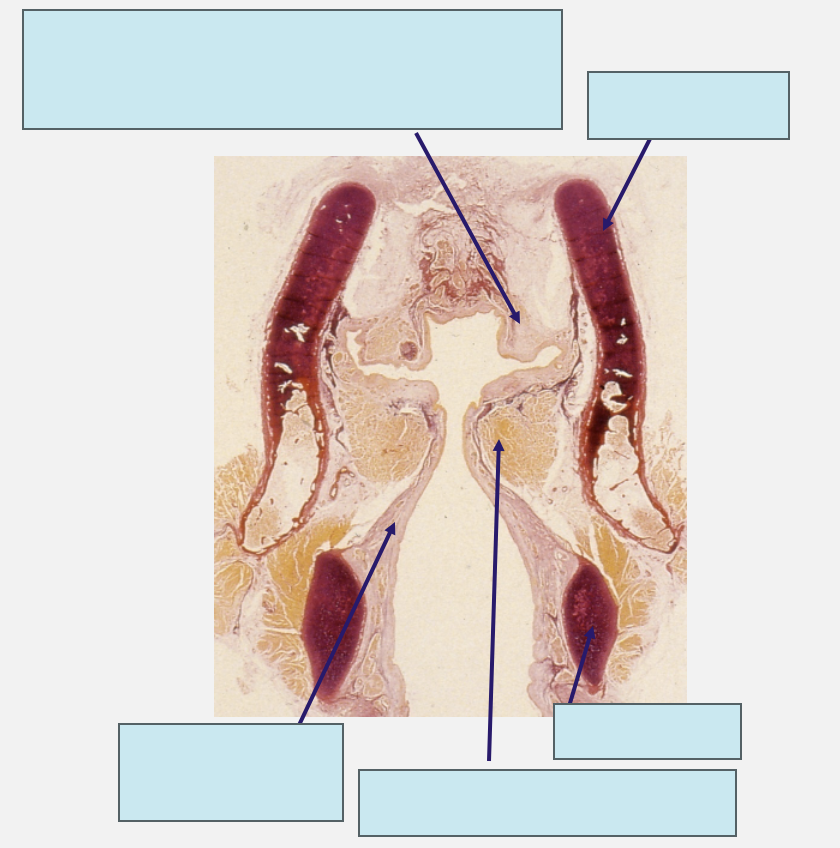
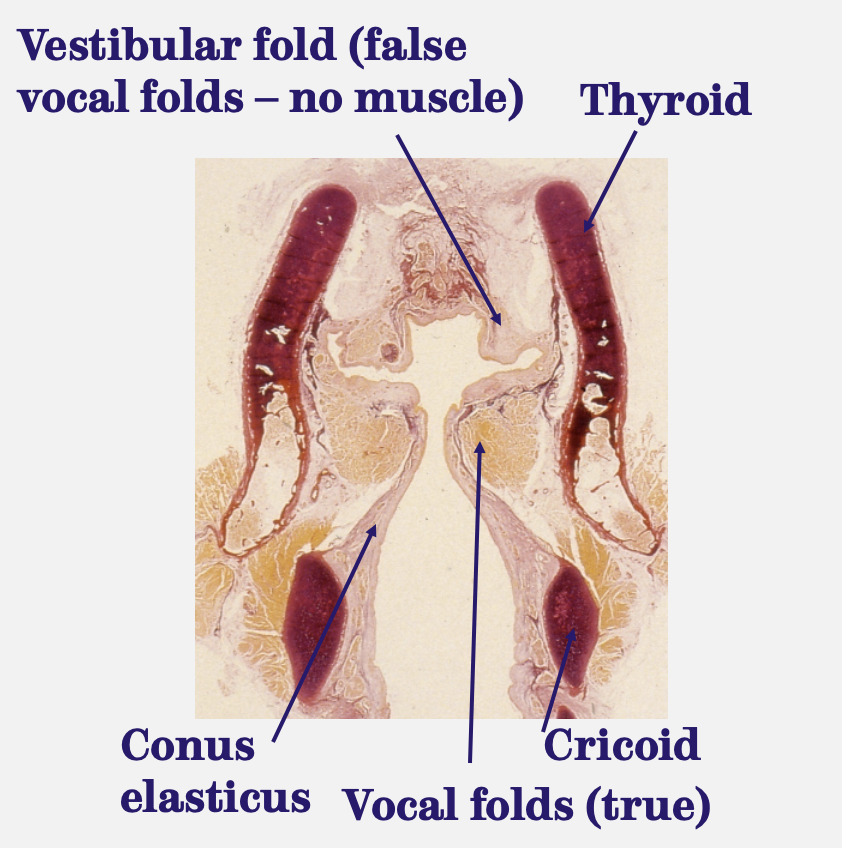
vertically the larynx is constricted at the _____ _____ by _____ _________
vertically the larynx is constricted at the vocal folds by conus elasticus i.e. the cricothyroid membrane
what type of tissue are the vocal folds/ cords made of
the vocal folds/ cords are made of smooth muscle tissue
another term for vestibular folds
false vocal folds/ cords
how are the vestibular folds specialised
the vestibular folds contain mucous glands which secrete mucus that lubricate the true vocal folds below
the vestibular folds have no muscle
which laryngeal folds vibrate
only the true vocal folds vibrate
what type of epithelium is found in the larynx
respiratory epithelium i.e. ciliated pseudostratified columnar epithelium
what structure in the larynx is the exception to being lined with respiratory epithelium
the vocal folds
vocal folds are lined with stratified squamous epithelium
why are vocal folds lined with stratified squamous epithelium
because they are constantly in contact (during adduction) and stratified epithelium provides durability


what is the laryngeal inlet
the opening of the larynx
what is the rima glottidis
the opening between the vocal cords

what is the rima glottidis formed by
the rima glottidis is formed by the vocal processes of the arytenoid cartilages and the vocal folds
laryngeal inlet vs rima glottidis
the laryngeal inlet and the rima glottidis are different regions of the same opening
the laryngeal inlet is superior to the rima glottidis
when are the vocal folds open and what is the exception
the vocal folds are usually open
except during swallowing and speech
what happens to the vocal folds during swallowing and speech
the vocal folds forcefully adduct during swallowing and speech
to protect the lower respiratory tract
what happens to the vocal folds during phonation
the vocal folds adduct
the tension of the vocal folds change
this causes pitch and volume to vary
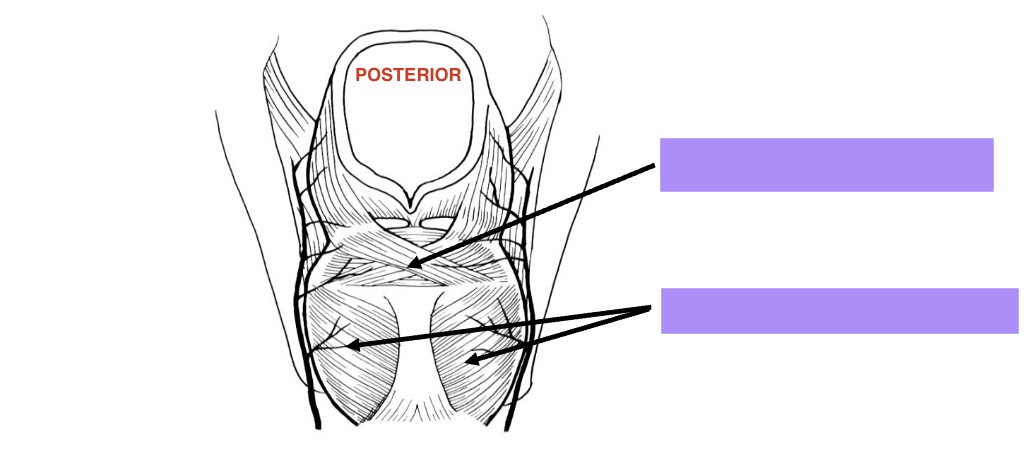
name these laryngeal muscles
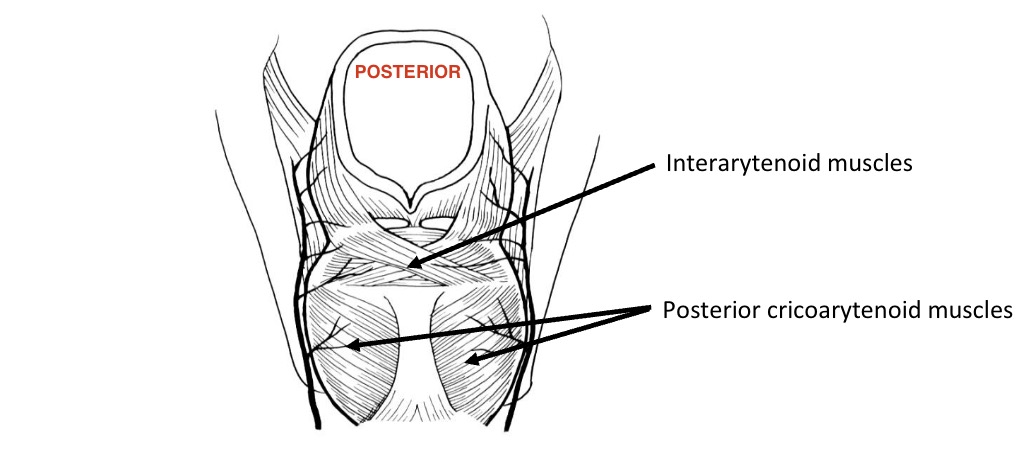
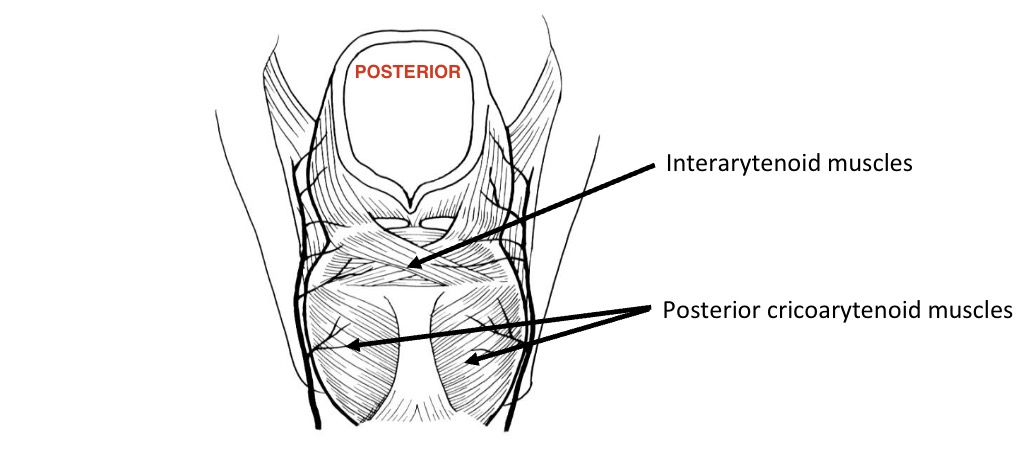
what is the function of the interarytenoid muscles
adduct the arytenoid cartilages
close the vocal folds

what is the function of the posterior cricoarytenoid muscles
abduct the vocal folds
the posterior cricoarytenoid muscles are the ONLY ABDUCTORS of the vocal folds
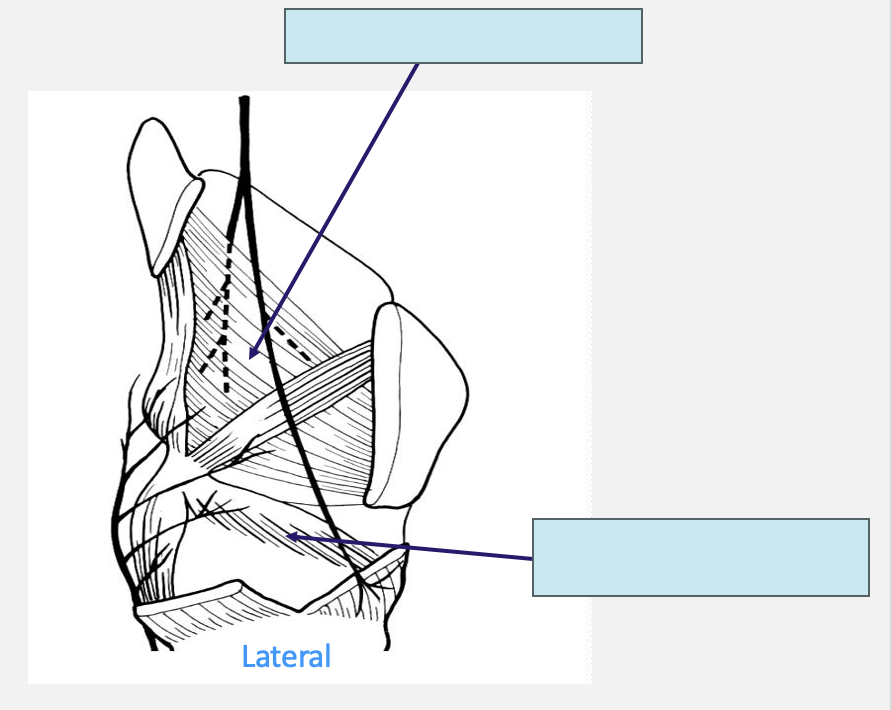
name these laryngeal muscles
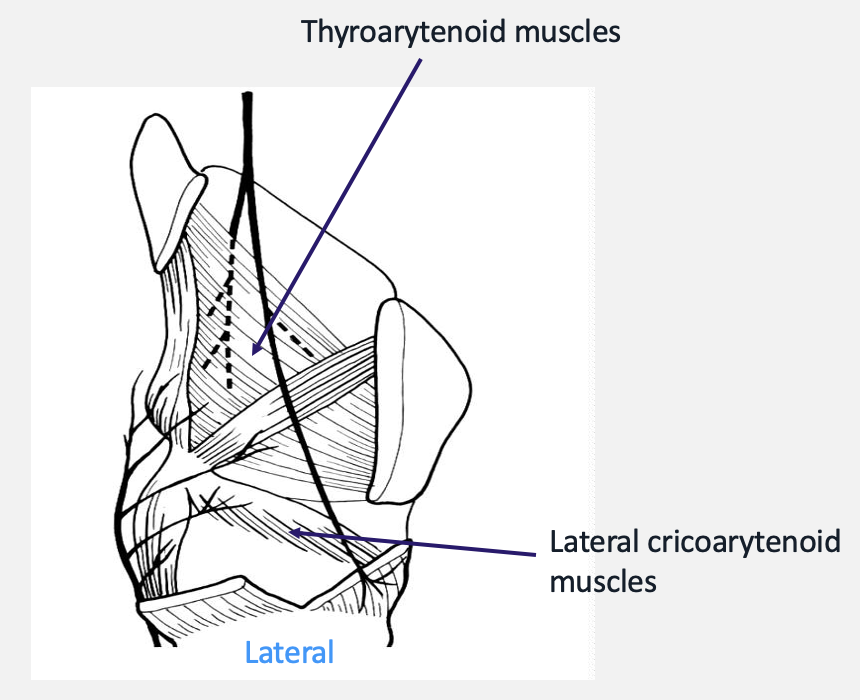
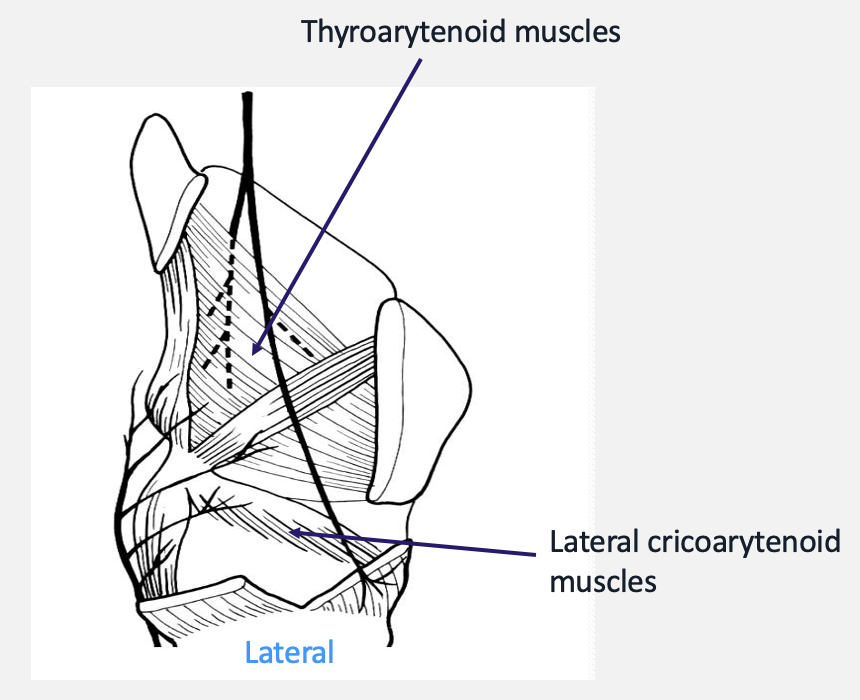
what is the function of the thyroarytenoid muscles
rotate the arytenoid cartilages inwards
adduct/ close the vocal folds during swallowing and shouting to forcibly close the vocal folds

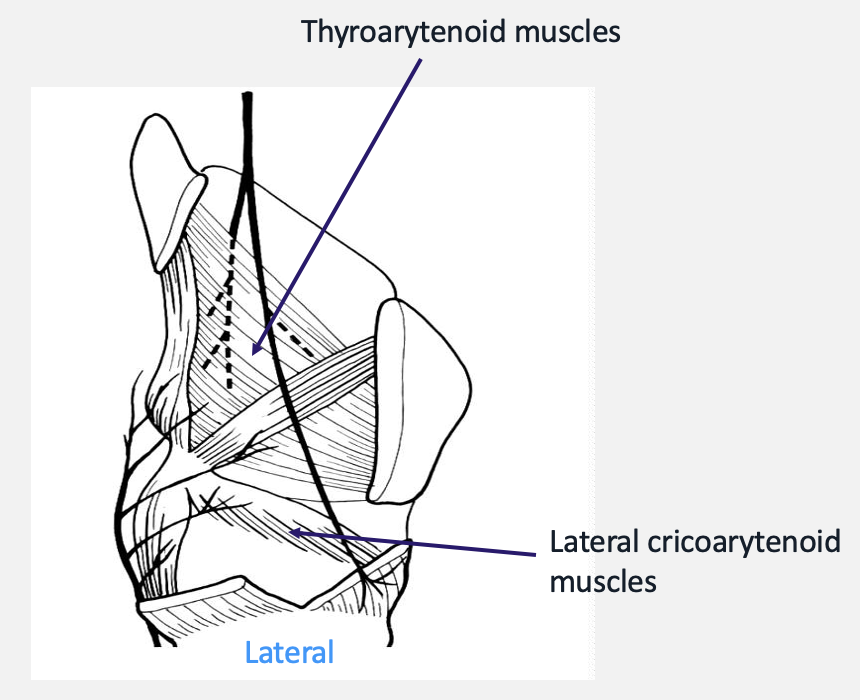
what is the function of the lateral cricoarytenoid muscles
rotate the arytenoid cartilages inwards
adduct/ close the vocal folds during swallowing and shouting to forcibly close the vocal folds
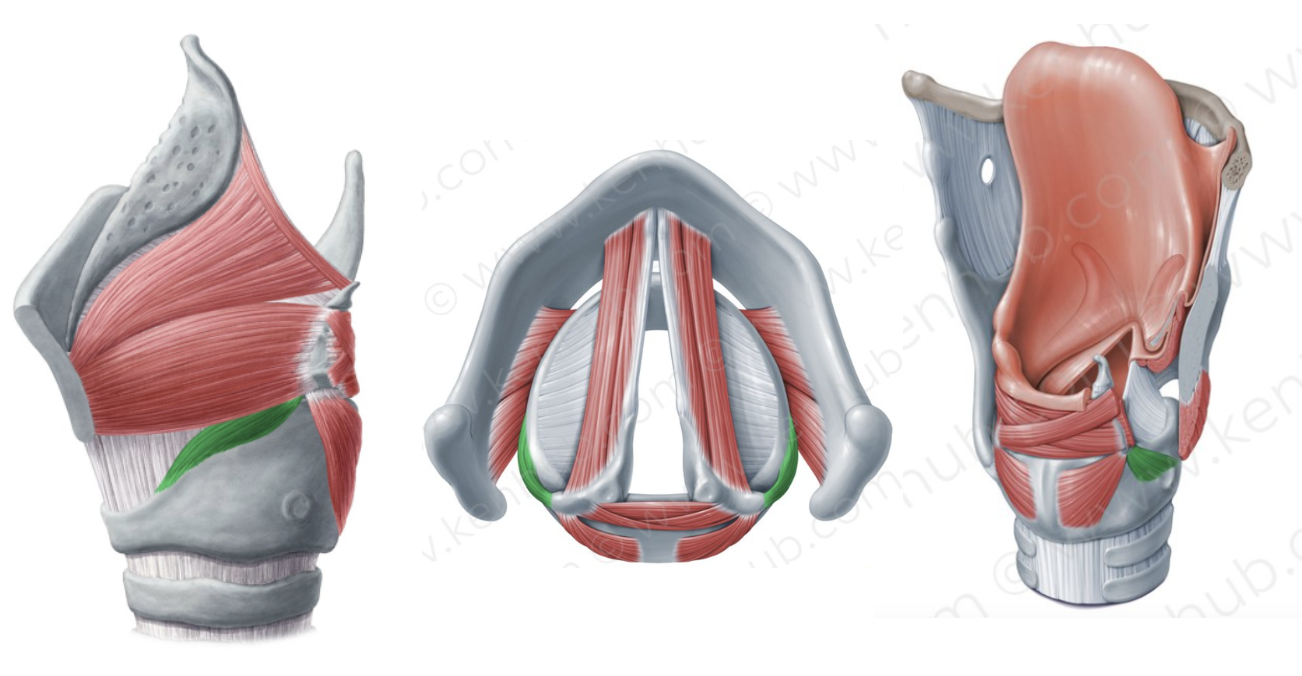

name this laryngeal muscle


what is the function of the cricothyroid muscles
act on the cricothyroid joint to move the cricoid cartilage upwards
this then moves the arytenoid cartilages backwards
the tension of vocal folds increase
—
these muscles make the initial adjustments to the tension of the vocal folds
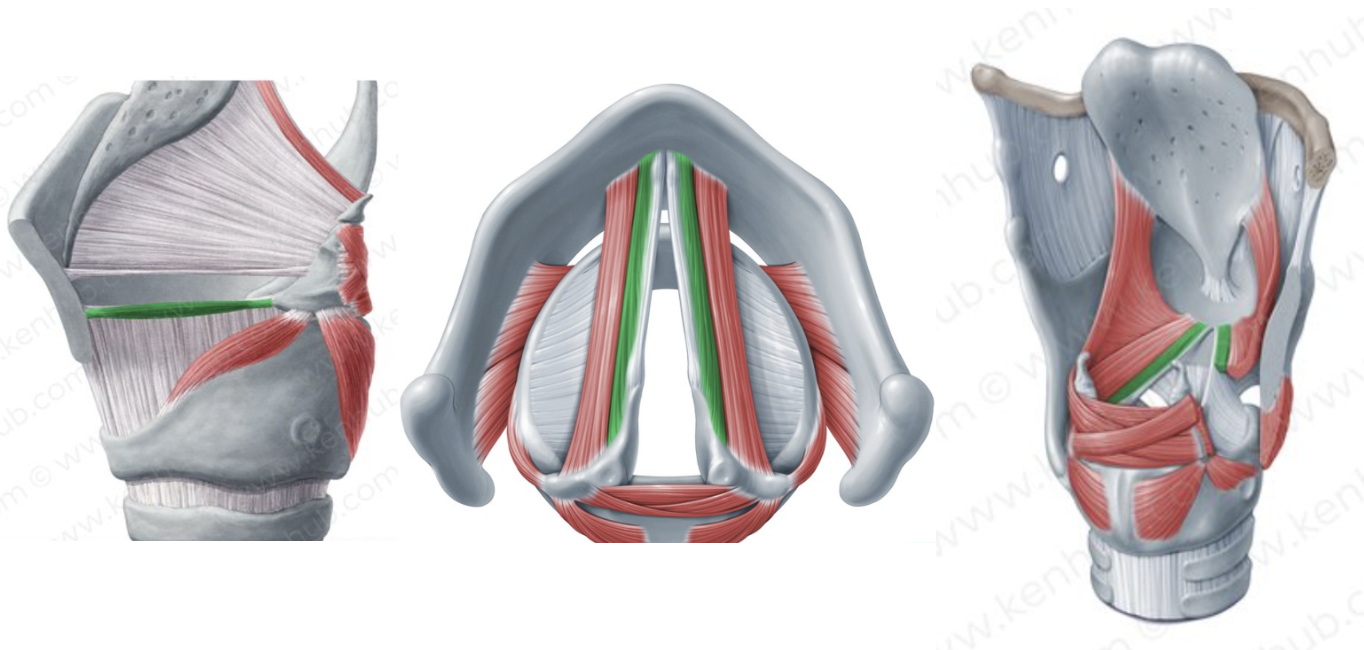
name this laryngeal muscle
vocalis (inner portion of thyroarytenoid)
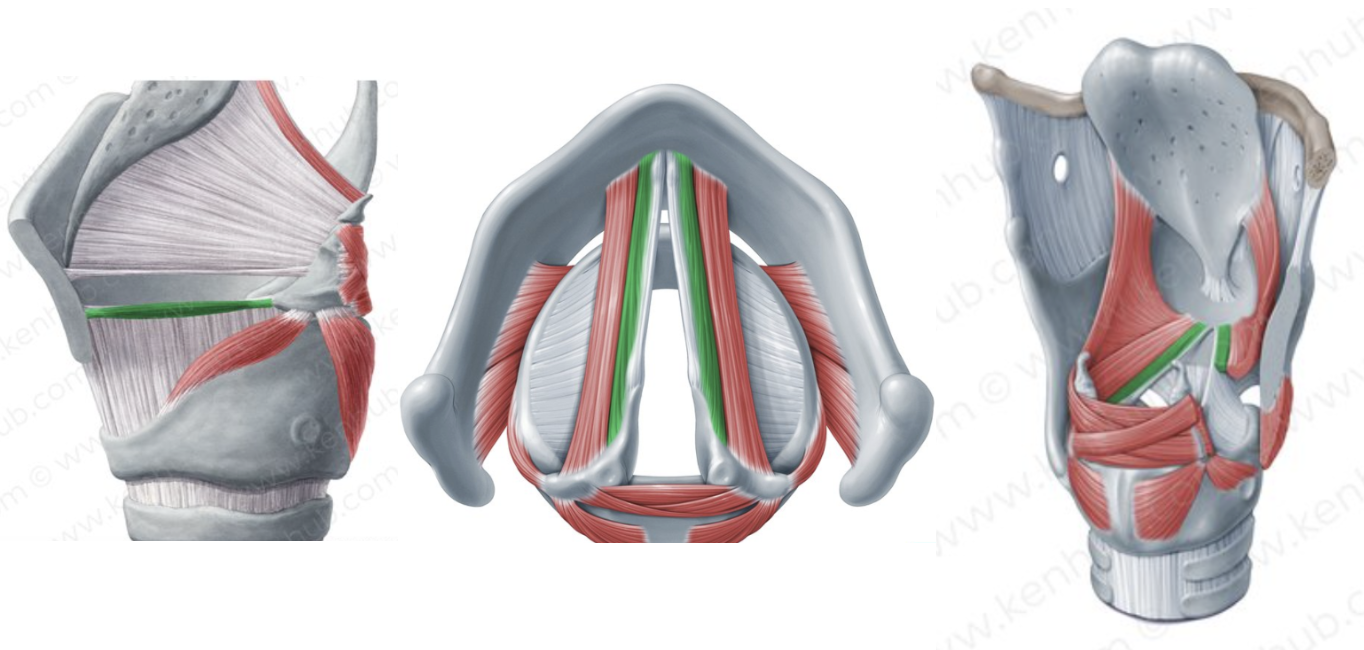
what is the function of the vocalis muscle
pulls the arytenoid cartilages forwards towards the thyroid cartilage
this relaxes the vocal folds
the vocalis also makes fine adjustments
what happens to the vocal folds during phonation
phonation requires closure of the vocal folds
what is another requirement of vocal folds for phonation
the vocal folds need to be closed and TENSED for phonation
how do the vocal folds open and close
closure of the vocal folds raises sub-glottal pressure (pressure of air) beneath the vocal folds
sub-glottal pressure increases until it is greater than the closing force of the muscles holding the vocal folds together
vocal folds open
as air rushes past it causes the vocal folds to vibrate
vocal folds close
cycle repeats
which variable factors in vocal folds affect pitch (3)
length
tension
thickness
how can the three variable factors be altered
moving the arytenoids backwards » stretching the vocal folds
moving the arytenoids forwards » relaxing the vocal folds
what does the resting length of vocal folds determine
the resting length of vocal folds determine habitual pitch
men > women > children
which nerve innervates the larynx
the vagus nerve/ CN X
which branches of the vagus nerve/ CN X innervate the larynx
the superior laryngeal nerve
recurrent laryngeal nerves
both are paired
how do the superior laryngeal nerves innervate the larynx
internal branches of SLN are sensory to the mucosa of the larynx
external branches of SLN are motor to the cricothyroid muscles
how do the recurrent laryngeal nerves innervate the larynx
RLN are motor to all other muscles of the larynx
(except the cricothyroid)
consequences of damage to the superior laryngeal nerves
loss of sensation to the larynx
inoperative cough reflex
inhalation of food into the respiratory tract i.e. silent aspiration
silent aspiration can lead to pneumonia and death
loss of motor innervation to the cricothyroid muscles
difficulty in regulating pitch
what is the typical nature of damage to the recurrent laryngeal nerve
damage to the recurrent laryngeal nerve is usually unilateral
causes of damage to the recurrent laryngeal nerves (2)
lung pathology - particularly the left RLN
thyroid gland operations - either side of RLN
consequences of damage to the recurrent laryngeal nerves
all muscles on affected side are paralysed
except the cricothyroid and interarytenoids
—
vocal folds will still be tensed as cricothyroid is functional
interarytenoids cross the midline and are therefore innervated bilaterally i.e. some RLN fibres on right innervate left muscle and vice versa so vocal folds are partially adducted » harsh raspy voice